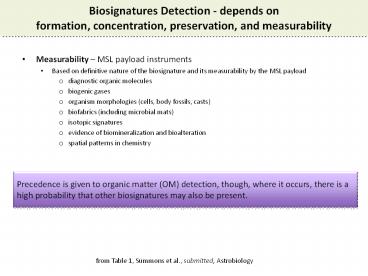Measurability PowerPoint PPT Presentation
1 / 7
Title: Measurability
1
Biosignatures Detection - depends on formation,
concentration, preservation, and measurability
- Measurability MSL payload instruments
- Based on definitive nature of the biosignature
and its measurability by the MSL payload - diagnostic organic molecules
- biogenic gases
- organism morphologies (cells, body fossils,
casts) - biofabrics (including microbial mats)
- isotopic signatures
- evidence of biomineralization and bioalteration
- spatial patterns in chemistry
Precedence is given to organic matter (OM)
detection, though, where it occurs, there is a
high probability that other biosignatures may
also be present.
from Table 1, Summons et al., submitted,
Astrobiology
2
Biosignatures Detection - depends on formation,
concentration, preservation, and measurability
- Formation - directly related to past habitability
assuming past life existed on Mars. - Water, energy sources (e.g., chemical gradients),
nutrient supply, - protection from extreme conditions (i.e.,
radiation and high heat) - Concentration - Depositional environments that
favored sedimentation of OM via retention and
hydrodynamic concentration - Same environments favor habitability
- Possibility of closely linked in situ
biosignature generation and burial - Preservation - Concentrations of sedimentary
minerals that protect OM from ionizing radiation
and chemical oxidation (e.g., phyllosilicates)
Summons et al., submitted, Astrobiology
3
Potential early Mars sedimentary environments
that would support organic C formation,
concentration, and preservation
Early Mars Environment Support for Support for Support for
Early Mars Environment Biotic ( abiotic) Corg formation Corg Concentration Corg Preservation
Aeolian sediments low low low
Regional groundwater pore system low low low
Alluvial Fan low low low
Fluvial channel low low low
Fluvial floodplain low-mod (low) low mod
Deltaic sediments high (low) high high
Lacustrine (perennial) high (low) high high
Lacustrine evaporitic (Cl-) med (low) high high-very high
Lacustrine evaporitic (SO4) low (low) high high-very high
from Table 3 of Summons et al., submitted,
Astrobiology
4
Potential early Mars volcanic and hydrothermal
environments that would support organic C
formation, concentration, and preservation
Early Mars Specific Cases Support for Support for Support for
Early Mars Specific Cases Biotic ( abiotic) Corg formation Corg Concentration Corg Preservation
Pyroclastics aqueous alteration (surface and subsurface) low low mod-high
Volcanic flows- aqueous altered surface low low low-mod
Volcanic flows- aqueous altered subsurface mod low low-mod
Volcanic flows- hydrothermal altered surface mod (low) low mod
Hydrothermal subsurface (lt100 C) mod mod-low mod
Hydrothermal surface (lt100 C) high (low) mod-high mod
Mafic and ultramafic subsurface (lt100 C) high (low) mod-high mod
from Table 4 of Summons et al., submitted,
Astrobiology
5
Habitability/Biosignature Preservation questions
for MSL
- Cyclic deposits. If there is any repeat
patterning to the horizontally layered basin
floor deposits or fan deposits and they contain
clay-rich layers or salts, then perhaps there may
be an opportunity for MSL to test for an
ecological record, like that suggested for Gale.
Alternatively, variations in lithofacies
laterally and with respect to the fan system may
be useful as a framework for investigating
paleo-ecosystems. - Horizontally layered deposits on the basin floor.
If these are lacustrine and fine grained, then
they are an optimal place to search for both
habitat features and preserved biosignatures. A
stratigraphic framework of a lacustrine/deltaic
system would be ideal for characterizing
habitability and detecting biosignatures but it
is not required. - Delta to basin correlation. If organic matter or
biosignatures are present in deposits, can we use
these to help correlate delta to basin strata?
6
Habitability/Biosignature Preservation questions
for MSL
- Most ancient fluvial deposits. Are there clay or
salt deposits associated with the more ancient
fluvial deposits underlying the horizontal
layered units in the basin floor? If clay layers
or salts are present, is there organic matter or
are biosignatures present in them? Is the
mineralogy or clast composition significantly
different than younger deposits, differences that
speak to different habitability? - Holden sediments. Do the sedimentary rocks in the
Holden ejecta suggest differences in the
habitability conditions of the Holden deposit?
Are there biosignatures present? Do these rocks
show alteration associated with the impact event
(hydrothermal) or later aqueous alteration?
7
Habitability/Biosignature Preservation questions
for MSL
- Clays in Strata Do the light toned layered units
at the base of the scarp and in horizontal
layered outcrops on the basin floor have
clay-bearing units within them (i.e.,
siltstones/mudstones)? Or is the clay distributed
within a more poorly sorted sediment? Milliken
CRISM spectral parameters indicate that both
swelling and non-swelling (mixed-layer) clay
minerals may be present at Eberswalde Can these
different types of clay minerals be related to
specific localities or deposits? Do they
correlate to organic matter character and
biosignatures? - Missing Salts. Is there a suite of salts present
in various units? Are they associated with
fine-grained deposits or clay minerals? Does the
salt mineralogy tell us about evolution of the
water chemistry of the lake during water level
fluctuations? Has the salt been redistributed by
post-depositional processes? Does the mineralogy
of salts and clay correlate to organic matter
character? - Carbon Cycle. Are their traces of carbonates
present? If so, are there any isotopic,
mineralogic, or other measurable variations over
time (based on stratal relationships)? If so, do
they relate to depositional changes? How do these
values compare to atmospheric CO2 and CH4
C-isotopic compositions? - Outcropping characteristics for biosignature
recovery. Does the outcropping of the basin floor
layered rocks versus the light-toned layered
rocks at the fan scarp offer any advantages in
terms of more recent erosional exposure or
protection from radiation. For example,
partially shaded exposures or exposures recently
exposed (e.g., mass wasting) may exhibit better
preservation.

